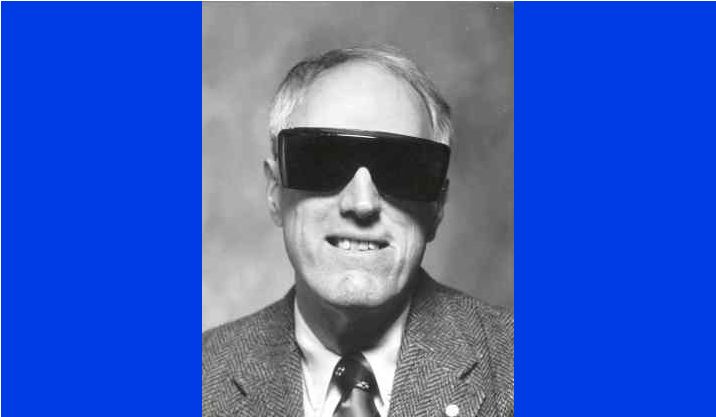
Going blind when you’re a chemist is a problem.
“It really helps to see when you’re doing chemistry,” said Charlie Leir, a retired 3M chemist who is fully blind.
A gun powder explosion when he was 14 years old led to the eventual loss of vision when Charlie was at the height of his technical career.
“I thought I might have to give up my lab work,” he said.
Far from it.
With help from colleagues, cutting-edge technology, a commitment from 3M and his own resilience, Charlie took that problem in stride and became one of the most prolific innovators in company history.
The accident
Charlie’s accident happened during a Fourth of July celebration in 1955. He was lighting gunpowder in a hollowed-out railroad axel that would cause loud explosions.
“The boom was so large that it would shake the ground,” he said.
Charlie would light a long fuse, giving him enough time to run away before the blast. But he accidentally lit the base of the fuse, causing the explosion to occur almost immediately. His face was inches from the barrel.
“I was blind that entire summer,” he said. “My lenses were clouded up with gunpowder.”
Eventually the gunpowder dissolved, and Charlie could see with limited vision. His eyesight continued to improve with the help of contact lenses and operations through undergrad and graduate school.
A chemistry candy store
Charlie came to 3M in 1970 just three years after earning his Ph.D. in organic chemistry from the University of Illinois.
His first 10 years with the company were spent designing methods for the synthesis of various agrichemicals and pharmaceutical molecules.
But it was in 1981, when he joined the newly formed Pressure Sensitive Adhesive (PSA) Technology Center, that Charlie found his home at 3M.
This was a group of cross-functional chemists tasked with developing novel materials that could be incorporated in new or existing tape products.
“We were a dynamic group and learned so much from each other,” he said. “It was like a chemistry candy store. It’s exactly what I wanted.”
More than that, Charlie forged life-long friendships. Two of those friends were George and Cheryl Moore, a married couple who are both highly accomplished inventors.
“Charlie was brilliant and had a great sense of humor,” said Cheryl.
“We were all great friends,” added George.
When the lights went out
Charlie’s contacts worked for him until the mid-80s when his vision declined rapidly.
He endured several surgeries in an attempt to fix his eyesight, but by 1989, at the age of 47, he was completely blind.
If that wasn’t enough, Charlie was also going through a divorce. He had recently moved into an apartment across the street from 3M and was feeling depressed.
George and Cheryl knew their friend was struggling and stepped in to help.
“Those two held my body and soul together,” said Charlie.
They moved Charlie into his new apartment, bought groceries, helped with laundry and even picked him up for work.
“The Moore’s kept my feet on the ground,” said Charlie.
A commitment to inclusion
Before Charlie was fully blind, 3M had already taken steps to accommodate his vision loss. One of its first actions was assigning a lab tech to help Charlie run experiments. Current 3M Scientist Audrey Sherman was one of his early lab techs.
“I would run reactions for Charlie and give him the play-by-play,” said Audrey. “He would want to know every detail. It felt like I was announcing a hockey game.”
His managers purchased the revolutionary Kurzweil Reading Machine, the first print-to-speech technology on the market, so Charlie could stay current on the latest scientific literature.
“I was the second person in history to own this machine.” said Charlie. “Stevie Wonder was the first.”
The creator of the reading machine, author, inventor and futurist, Ray Kurzweil, actually collaborated with several blind scientists to refine the user interface. The innovation was a great advancement in the field of assistive technology.
“Stories like Charlie’s are deeply gratifying to me,” said Ray. “There are no limitations to being blind with the right alternative techniques, as there are no limitations to any disability when the right ideas and technologies are applied.”
Along with the reading machine, 3M facilitated white cane training and coordinated transportation for Charlie to and from work.
“3M had all the ingredients to keep me functional,” he said. “It was the right atmosphere for me.”
Visualize the problem
Charlie was more than functional. He was prolific.
His work led to discoveries that were used in many applications including diaper tape, packing tape, window film, medical adhesives, and much more.
He retired as a corporate scientist in 2008, tallying up 81 U.S. patents and earning a spot in 3M’s Carlton Society, the company’s most prestigious honor for technical achievement.
“If I had to do it over again, I’d prefer that I didn’t go blind, but you can’t change that,” he said. “I had to get over it.”
One thing that did change was Charlie’s cognitive abilities and his visualization skills. Co-workers remember Charlie would sit in his office for hours and just think about a particular problem.
“He was able to run chemical reactions in his head; more than we could do in the lab,” said Audrey. “And over time, he became really good at predicting outcomes.”
Charlie agrees that his mental aptitude was likely augmented after he went blind.
“I had to concentrate harder than I ever did before,” he said. “That probably sharpened my perception.”
Charlie proved you don’t have to see to do chemistry. You just need to believe in yourself. And that’s his message to aspiring scientists who face physical limitations.
“If you’re intelligent enough to operate at a high level, then you’re intelligent enough to solve big problems,” he said. “Enlist the help of others and don’t get discouraged.”
Problem solved.
